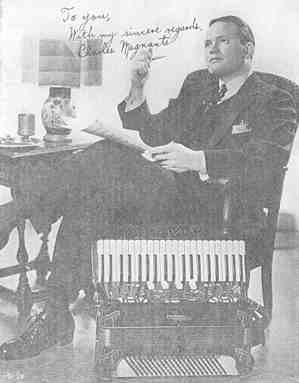Read Accurately At And Master Technique Is Advice To Would-Be Orchestra Accordionists


It is now more than ten years since the accordion was first used in orchestra, but it is only in the past year or two that it is noticeably being accepted by leaders on a par with other instruments. To illustrate: A few years ago, when playing with a large orchestra, I found that leaders generally didn't want to use the accordion as part of the rhythm section. They would have it spotted for eight or sixteen measures here and there, or use it for a solo. The remainder of the time it could rest. Today, the accordion is considered of real importance in the rhythm section, by leader and fellow musicians alike. You will notice, these days, that the accordionist plays right on through a program with his fellow musicians!
To be a successful orchestra accordionist is the aim of innumerable students. The work pays good money, and is interesting besides. Many of these aspiring musicians, however, think that as soon as they can play a few popular numbers well, they are all set for orchestra work. It is almost needless to say that they are over-optimistic.
Here are two vital questions to ask yourself before looking for an orchestra job:
Can I read accurately at sight?
Have I mastered technique?
If you can truthfully answer "Yes" to both these questions, you are justified in feeling ready for orchestra work.
The value and necessity of sight reading cannot be overemphasized. Orchestra rehearsals are held for the benefit of the ensemble, not for individual study. The accordionist must be able to lay at sight any piece of music that is handed him. The fact that he must work from a piano or violin score makes his lot a particularly difficult one. By all means he must be able to read bass clef.
Technique is a broad subject. Briefly, it includes being able to play rapidly, without errors, and at the same time to play clean. It is a common fault, when playing fast, to slur and even skip notes. Each note, no matter what its time value, should be played distinctly.
The proper manipulation of the bellows is a technique in itself. Just what "proper" manipulation means cannot be explained in a few words. It is a subject for long, careful study. But I do want to call attention to its importance--for it plays a big part in effective syncopation.
A thorough knowledge of harmony is a valuable asset to any musician who really wants to get to the top. But I consider that an understanding of pract ical harmony is an absolute necessity for an orchestra accordionist; that is, he must at least learn the formation of chords in all different keys.
The size and style of the orchestra you are working with somewhat influences your manner of playing. But at all times it is necessary to use musical intelligence. That is, listen to your own instrument. If it rides out over the rest of the orchestra too noticeably, subdue it. Watch your leader. You can tell pretty quickly whether or not he likes how you are handling your part. And if he doesn't seem pleased, try at once for a different effect. Few orchestra leaders really understand the use of an accordion, and it is the responsibility of the accordionist to make the leader like it. The leader cannot suggest to him what to do; he must figure it out for himself.
Remember the importance of rhythm whether you are playing with a group or five or fifty. At times you may be the whole rhythm section, and again just a small part of it, but in either case you can upset the whole ensemble by failing to keep the same tempo throughout a dance selection.
When I play a straight chorus, I fill in a lot of harmony with the melody, so that I have full chords. When playing a hot chorus, I try to play around the original melody, always bearing in mind the harmonic structure for each measure.
Working with a small orchestra of five or six men is more difficult than a larger group, for the accordion then should bang out trumpet effects in full chords to cut through the melodic section. When there is no brass, the accordion can substitute for that section, by using a full register in the right hand.
One more bit of advice; and this is especially directed to orchestra men playing club engagements. Conserve your energy. Learn to produce the music with the smallest amount of air. If you have mastered the technique of bellowing, you can do this. Laborious pulling not only looks badly, but is physically tiring. To be really successful, your music must have the same pep when you play "Bye Bye Blues" that it had at the beginning of the evening.
Photo caption: Charles Magnante, popular radio artist, whose success series is running exclusively in THE ACCORDION WORLD.
The Classical Free-Reed, Inc. staff gratefully acknowledges volunteer Patrick Kiley who assisted in the production of this article, as well as Stanley Darrow and his comprehensive American Accordion Musicological Society library.
| Charles Magnante: Background For Success, Part 5 |
| Invitation to Contributors / Submission Guidelines |
| Back to The Free-Reed Journal Contents Page |
| Back to The Classical Free-Reed, Inc. Home Page |